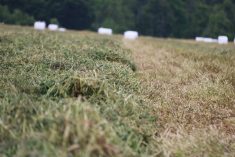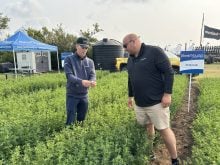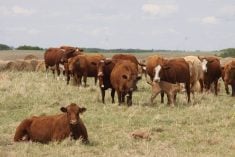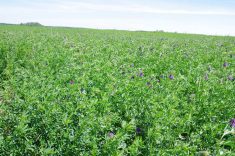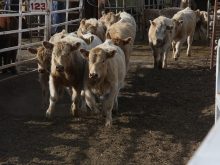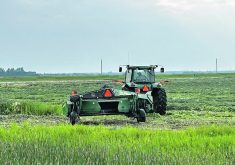Survey will gather data from 1991-94 and 2016-19 about all aspects of forage production from seeding to the final crop
CALGARY — A researcher is offering $200 to each Saskatchewan cattle forage producer who completes an online survey he expects will help counter what he called false greenhouse gas narratives targeting the beef industry.
Judson Christopherson says he hopes to determine if the amount of carbon that’s being sequestered in soil by forage crops in the province outweighs emissions by sources such as farm machinery and fertilizer.
Related stories:
- No miracle solutions expected to reduce cattle emissions
- Canada tackles cattle methane emissions
- Genetics may answer methane riddle
- It’s a disaster
Read Also

Feds propose overhaul of chronic wasting disease control program
Chronic Wasting disease control program getting updated by Canadian Food Inspection Agency with feedback encouraged from producers.
“It’s just to bring balance to the narrative that it’s cattle that are a large contributor to climate change, global warming, whatever you want to call it.”
Christopherson is a third-generation beef producer who ranches near Yellow Grass, Sask. He is conducting research for his master’s thesis at the University of Saskatchewan, where he aims to earn a master of science degree in agricultural economics.
He is looking for 50 to 100 Saskatchewan beef cattle forage producers to undertake the online Forage Rotation Survey. Participants can also include producers of forage as a cash crop because they are likely selling most of what they grow to the cow-calf sector, he said.
He expects the survey will take 30 minutes to three hours to complete, and those who complete it fully will receive $200.
“You’ve got to compensate people for both their time and their willingness to share the data.”
The project is funded by the Saskatchewan Cattlemen’s Association and being supervised by Stuart Smyth, who is the Agri-Food Innovation and Sustainability Enhancement chair at the university. It seeks to evaluate the progress of beef forage producers toward sustainable farming practices, helping to better inform the public and governments as they develop policies.
Christopherson pointed to stories by the media that he said fail to tell the whole story about issues such as methane from cattle. The Canadian Cattle Association criticized the Weather Network in 2019 for posting a message on Twitter, now known as X, that linked to a video citing a study by the World Resources Institute.
“If you really want to help save the planet, you could seriously consider limiting the amount of beef you eat,” said the tweet.
Christopherson said if such messages continue to spread unchecked, they could damage the integrity of the entire beef supply chain.
“It’s a narrative that hasn’t really been subscribed to by consumers yet, but we see some media pundits, politicians and activists really subscribing to the theory that it’s enteric emissions methane (from beef cattle) that is causing a lot of our issues regarding climate.”
Enteric emissions are a natural consequence of the digestive process in ruminant animals such as cattle. The United Nations’ Environment Programme has described methane as being about 80 times more potent a greenhouse gas than carbon dioxide during the first 20 years after it is released.
The global organization estimated in 2021 that livestock emissions, including sources such as manure, constitute roughly 32 percent of human-caused methane. Christopherson said such estimates fail to consider the steps Canadian producers have taken to sequester more atmospheric carbon in the soil, or that methane emissions from cattle need to be viewed as part of a larger natural cycle where the gas is converted to carbon dioxide and returned to soils through plant growth.
Another important point is that beef forage crops are often being raised on marginal land, he said.
“And when I say marginal land, what I mean is this is land with significant barriers to crop production, so you cannot grow lentils or even wheat on this land, right?”
It is not useful for anything but forage production, which ultimately turns land with no value for humans into beef with a high nutritional value for people, said Christopherson.
“And so, when you’re looking at the carbon this takes in versus the outputs, it has to be in that context that the next best land use in most cases is nothing.”
The survey will gather data from 1991-94 and 2016-19 on all aspects of forage production ranging from seeding, fertilizer and tillage to the final crop. However, people do not need to have farmed in both periods to take part in the survey.
The data will be combined with existing research into carbon sequestration that has been inputted into the Holos model created by Agriculture Canada, said Christopherson. Holos is a software application that estimates changes in soil carbon and greenhouse gas emissions in Canadian farming systems.
“And it’s a whole farm simulation model where you can input production practices, and you get out the emissions and also some of the economic indicators,” said Christopherson.
“I’ll be more interested in looking at the emissions, and so, once I get the survey responses in and I can start inputting that into the Holos model and I get the outputs, then I can assign economic valuation to the sequestration or emissions depending on which way the results go using a variety of factors.”
The survey began in early September and about 20 producers had taken part as of Jan. 10.
“I think there’s a little bit of reluctance to share data. I wouldn’t say that’s the main reason,” said Christopherson.
“I would say the main reason is that people are busy, and if they’re going to spend time sitting at their computer, it’s going to be to do their books or do some planning, and they don’t want to sit there for another minute when they’re done. So, it’s convincing people who would much rather be outside with their livestock than just sitting at their laptop, and that can be difficult.”
Visit www.surveymonkey.ca/r/forage-registration to take part in the survey.




